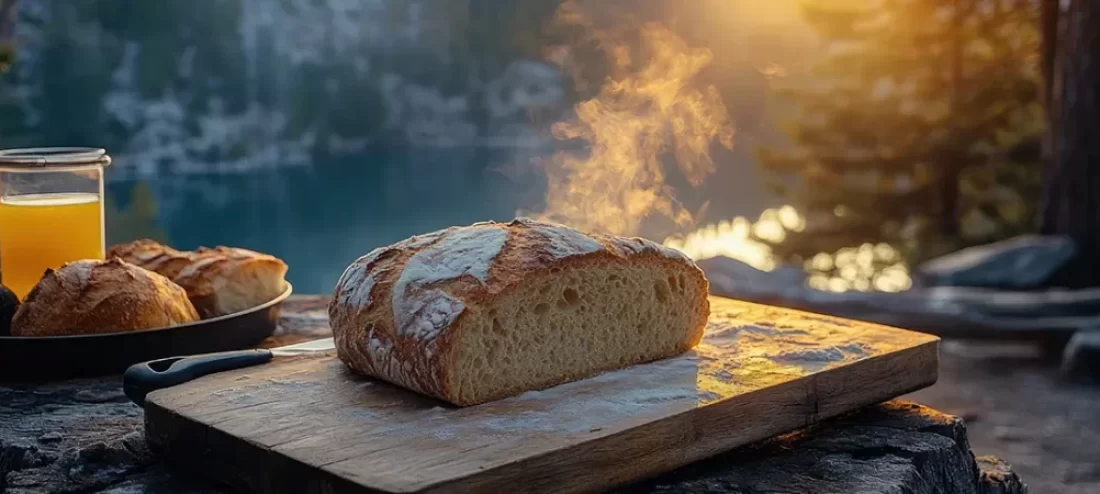Fly Fishing and Sourdough Camping in Montana’s Rivers
Montana’s rivers are a fly angler’s paradise, where towering mountains frame crystal-clear waters teeming with trophy trout. Fly Fishing and Sourdough Camping Montana, Floating these rivers, camping under starlit skies, and cooking over a crackling campfire create an unforgettable adventure. Add the tangy aroma of sourdough baked in a Dutch oven, and you’ve got the recipe for a perfect Montana experience. This article explores the art of fly fishing Montana’s iconic rivers, the joys of riverside camping, and how to whip up delicious sourdough recipes over a campfire.
Fly Fishing Montana’s Legendary Rivers
Montana boasts over 170,000 miles of rivers and streams, many designated as “blue-ribbon” trout fisheries. Rivers like the Madison, Yellowstone, Missouri, and Smith offer diverse waters, from swift riffles to deep pools, home to wild rainbow, brown, cutthroat, and brook trout. Floating these rivers in a drift boat or raft maximizes access to prime fishing spots, allowing anglers to cover miles of water in a day.
-
Madison River: Known for its swift currents and high trout counts (over 6,000 per mile in some stretches), the Madison River flows from Yellowstone National Park to the Missouri River. Its “fifty-mile riffle” near Ennis is a hotspot for trophy rainbow and brown trout, especially during summer hatches of caddisflies and grasshoppers.
-
Yellowstone River: The longest undammed river in the contiguous U.S., the Yellowstone River offers freestone fishing at its finest. Upstream of Livingston, it’s a world-class trout fishery with cutthroat, rainbow, and brown trout. Summer and fall bring epic dry fly fishing with hoppers and mayflies.
-
Missouri River: Below Holter Dam, the “Mo” is a tailwater fishery renowned for dry fly fishing and large trout (some exceeding 20 inches). Its high fish density near Craig makes it a bucket-list destination.
-
Smith River: A 59-mile wilderness float through limestone canyons, the Smith is a permit-only river with limited access, ensuring pristine conditions and healthy trout populations. It’s a multi-day adventure blending fishing and camping.
-
Bighorn River: Below Yellowtail Dam, the Bighorn River is a premier tailwater fishery with consistent flows and abundant trout, including browns and rainbows averaging 16–18 inches. Its clear waters near Fort Smith are ideal for technical dry fly and nymph fishing year-round.
-
Clark Fork River: Flowing through western Montana, the Clark Fork River is a diverse fishery with healthy populations of rainbow, brown, and westslope cutthroat trout. Its scenic stretches near Missoula offer excellent dry fly fishing during summer stonefly and mayfly hatches.
Fishing Tips:
-
Timing: June to October is prime, with July–August ideal for dry flies and September–October for aggressive brown trout pre-spawn. Early mornings beat the heat and catch active fish.
-
Gear: Bring 6-weight fly rod for trout and a 10-Weight Fly Rod for Montana Musky, floating lines, and a variety of flies (e.g., Parachute Adams, Elk Hair Caddis, hoppers). Loaner gear is available on guided trips, but pack your favorite setups.
-
Regulations: Secure a Montana fishing license and check local rules—some areas are catch-and-release only.
-
Guides: For beginners or remote rivers, hire a guide from outfitters. They navigate, set up camps, and share local knowledge.
Camping Along Montana’s Rivers
Riverside camping elevates a fly fishing trip into a full immersion in Montana’s wild beauty. Deluxe camping options, offered by outfitters, include gear rafts that float tents, cots, sleeping pads, tables, and solar showers downriver. Alternatively, DIY campers can pitch tents on public lands or at designated sites like Camp Baker (Smith River) or along the Gallatin and Madison.
-
Setup: Choose a flat, elevated site away from the riverbank to avoid flooding. Use lightweight tents and pack warm sleeping bags for chilly Montana nights (even in summer).
-
Amenities: Guided trips provide gourmet meals (think grilled salmon or ribeye steaks), but DIY campers should pack coolers with ice for fresh food and a portable stove as a backup.
-
Leave No Trace: Follow the seven Leave No Trace principles—pack out all trash, minimize campfire impact, and respect wildlife to preserve Montana’s pristine rivers.
After a day of casting, nothing beats gathering around a campfire. Use hardwoods like oak or alder for clean-burning coals, avoiding resinous pines that can taint food with a turpentine flavor. A steady supply of small logs keeps flames lively for cooking, while hot coals provide consistent heat for Dutch ovens.
Trophy Trout Over the Campfire
Catching a trout and cooking it over a campfire is a Montana tradition. Fresh trout, with its delicate, flaky flesh, absorbs the smoky essence of the fire, creating a meal that rivals any restaurant. Here are two simple recipes for campfire trout, adapted from trusted sources.
Campfire Trout in Foil
Ingredients (Serves 2):
-
2 whole trout (12–14 inches), cleaned and dressed
-
1 lemon, thinly sliced
-
1 small onion, chopped
-
4 tbsp unsalted butter
-
Salt and pepper to taste
-
Optional: 2 strips bacon or fresh herbs (dill, rosemary)
Instructions:
-
Build a hot campfire with a bed of coals (use oak or alder).
-
Tear off two sheets of heavy-duty aluminum foil, each 6 inches longer than the trout.
-
Splash 1–2 tsp water on each foil sheet to create steam.
-
Season trout cavities with salt and pepper. Stuff with chopped onion, 2–3 lemon slices, and 2 tbsp butter (or bacon/herbs).
-
Place each trout in the center of a foil sheet, fold tightly into packets, and secure with a metal toasting rod for easy handling.
-
Bury packets in hot coals and cook for 7–10 minutes, depending on fire heat, until flesh flakes easily.
-
Carefully remove, let cool for 2 minutes, and serve with a squeeze of fresh lemon.
Tips: Keep the fish whole to retain moisture. For a smoky flavor, place packets 6 inches above coals on a grill grate for 4–8 minutes per side.
Herb-Stuffed Trout in a Cast Iron Skillet
Ingredients (Serves 2):
-
2 trout fillets (or 1 whole trout, butterflied)
-
2 tbsp olive oil
-
2 tbsp unsalted butter
-
1 lemon, juiced and sliced
-
Fresh dill or rosemary, chopped
-
Salt and pepper to taste
Instructions:
-
Start a campfire and preheat a cast iron skillet over coals for 3–5 minutes.
-
Coat trout with olive oil, season with salt and pepper, and stuff with lemon slices and herbs (or layer herbs between fillets).
-
Add butter to the hot skillet, then place trout skin-side down. Cook for 7–8 minutes.
-
Flip and cook 2–3 minutes until golden and flaky.
-
Drizzle with lemon juice and serve directly from the skillet.
Tips: Tie fillets together with kitchen twine if stuffing. Ensure the skillet is well-buttered to prevent sticking.
Sourdough Recipes for the Campfire
Sourdough, with its tangy flavor and chewy texture, pairs perfectly with fresh trout and campfire vibes. A sourdough starter thrives in Montana’s cool nights, and a cast iron Dutch oven makes baking over coals a breeze. Below are two campfire sourdough recipes to complement your fishing adventure.
Campfire Sourdough Bread
Ingredients (Makes 1 loaf):
-
100g active sourdough starter (fed 4–8 hours prior, bubbly and doubled)
-
350g bread flour
-
50g whole wheat flour
-
275g lukewarm water
-
10g salt
Instructions:
-
At home (day before): Mix starter, water, and flours in a bowl until shaggy. Rest for 30 minutes. Add salt and knead for 5 minutes until smooth. Cover and let rise for 8–12 hours at room temperature. Punch down, shape into a ball, and place in a floured banneton or bowl. Refrigerate to transport.
-
At camp: Build a campfire and prepare a bed of hot coals (about 400°F). Preheat a 4-quart cast iron Dutch oven with the lid on for 30 minutes.
-
Remove dough from cooler, place on parchment paper, and score the top with a sharp knife.
-
Carefully place dough (with parchment) in the hot Dutch oven. Cover and set on a bed of coals, piling more coals on the lid.
-
Bake for 30–35 minutes, removing the lid for the last 10 minutes to brown the crust.
-
Cool for 20 minutes before slicing. Serve with butter or alongside trout.
Tips: Use a thermometer to check coals (aim for 375–425°F). If the starter is sluggish, feed it twice daily at camp with 50g flour and 50g water.
Sourdough Campfire Pancakes
Ingredients (Serves 4):
-
200g discarded sourdough starter (unfed, straight from cooler)
-
1 egg
-
100g all-purpose flour
-
120g milk (or water)
-
2 tbsp sugar
-
1 tsp baking powder
-
1/2 tsp baking soda
-
1/4 tsp salt
-
2 tbsp melted butter (plus more for skillet)
Instructions:
-
In a bowl, mix starter, egg, milk, and melted butter until smooth.
-
Combine flour, sugar, baking powder, baking soda, and salt in another bowl. Stir into wet ingredients until just combined (lumps are okay).
-
Heat a cast iron skillet over campfire coals (medium heat, about 350°F). Add a pat of butter to grease.
-
Pour 1/4 cup batter per pancake onto the skillet. Cook for 2–3 minutes until bubbles form, then flip and cook 1–2 minutes until golden.
-
Serve with maple syrup or fresh berries from Montana’s trails.
Tips: Use a cooler to keep milk fresh, or substitute powdered milk. Cook over coals, not open flames, to avoid burning.
Bringing It All Together
A Montana fly fishing trip is more than casting for trophy trout—it’s a sensory journey. The rhythm of floating down the Madison or Yellowstone, the crackle of a campfire under a Big Sky sunset, and the aroma of sourdough baking in a Dutch oven weave together an experience that lingers long after the trip ends. Whether you’re a seasoned angler or a novice, Montana’s rivers offer endless opportunities to hook a trophy trout, camp in pristine wilderness, and savor meals cooked over an open fire.
Planning Tips:
-
Permits: Apply early for Smith River float permits through Montana Fish, Wildlife & Parks.
-
Outfitters: Book with Montana Angler or Frontiers for guided fishing and camping (prices start at $5,350 for a 4-night Smith River trip).
-
Packing: Pack lightweight fishing gear, a cooler for trout and ingredients, and a Dutch oven for sourdough. Check fire restrictions before lighting campfires.
-
Sourdough Starter: Start your sourdough culture 5–7 days before the trip (see my previous response for a starter recipe). Keep it in a sealed jar in a cooler during travel.
As you drift along Montana’s rivers, rod in hand, with the promise of a campfire feast ahead, you’ll understand why this state is the last best place for fly fishing and outdoor living. So, cast a line, pitch a tent, and let the fire-roasted trout and sourdough fuel your adventure.
Creating Sourdough Starter
Sourdough pancakes, breads, even torta shells is great with any meals.
The best morning are a campfire with sourdough pancakes on the griddle.
Creating a sourdough starter from scratch is simple but requires patience, as it takes about 5–7 days to develop an active culture of wild yeast and bacteria. Below is a concise guide to making your own sourdough starter.
Ingredients
- Flour: Whole wheat or rye flour (for initial feedings, to boost microbial activity) and unbleached all-purpose or bread flour (for maintenance).
- Water: Filtered or dechlorinated water, ideally lukewarm (around 80°F/27°C).
Equipment
- Clean glass or plastic container (1-quart capacity, ideally).
- Non-reactive spoon or spatula.
- Loose-fitting lid or breathable cover (e.g., cloth or coffee filter with a rubber band).
- Scale (for precise measurements by weight).
Daily Process (7-Day Guide)
Use a 1:1:1 ratio by weight (starter:flour:water) unless specified. Keep the starter at room temperature (70–75°F/21–24°C) in a draft-free spot.
Day 1: Start the Culture
- Mix 100g whole wheat or rye flour with 100g lukewarm water in the container.
- Stir until smooth (like thick pancake batter).
- Cover loosely and let sit for 24 hours.
Day 2: First Feeding
- You may see small bubbles or no activity yet—this is normal.
- Discard half the mixture (about 100g).
- Add 50g all-purpose flour, 50g whole wheat or rye flour, and 100g lukewarm water. Stir well.
- Cover and let sit for 24 hours.
Day 3–5: Build the Culture
- By Day 3, you should see bubbles and a mild yeasty or tangy smell. If not, don’t worry—it’s still developing.
- Each day, discard all but 50g of starter.
- Feed with 50g all-purpose flour (or a mix of all-purpose and whole wheat) and 50g lukewarm water. Stir until smooth.
- Cover and let sit for 24 hours.
- If activity is slow (no bubbles or rise), feed twice daily (every 12 hours) or move to a warmer spot (75–85°F/24–29°C).
Day 6–7: Strengthen and Test
- By now, the starter should double in size within 6–8 hours after feeding, have a bubbly surface, and smell pleasantly tangy or yeasty.
- Continue discarding all but 50g and feeding with 50g all-purpose flour and 50g water once or twice daily.
- To test readiness, perform the float test: Drop a teaspoon of starter into a glass of water. If it floats, it’s ready for baking. (Note: This test isn’t foolproof—rely on visual cues like doubling and bubbles.)
Tips for Success
- Consistency: Feed at the same time daily to establish a rhythm. Weigh ingredients for accuracy.
- Flour Choice: Whole wheat or rye flour jumpstarts fermentation due to higher nutrient content. Transition to all-purpose for a milder flavor after Day 2.
- Water: Chlorinated water can inhibit microbes. Use filtered water or let tap water sit for 24 hours.
- Temperature: Warmer temperatures (75–85°F/24–29°C) speed up fermentation; cooler ones slow it down.
- Patience: If the starter isn’t active by Day 7, continue feeding for a few more days. Slow starts can happen due to flour type or environment.
- Discard Use: Use discarded starter in recipes like pancakes, waffles, or crackers to reduce waste.
Troubleshooting
- No Bubbles by Day 3: Use warmer water, move to a warmer spot, or add a pinch of rye flour. Ensure the container is clean and water is dechlorinated.
- Foul Smell (like acetone or cheese): Normal in early stages. Keep feeding daily; the smell should become pleasant. If mold appears, discard and start over.
- Grayish Liquid (Hooch): Stir it back in during feedings—it’s a sign the starter is hungry.
When It’s Ready
Once the starter consistently doubles in size within 4–8 hours after feeding and has a bubbly texture and tangy smell, it’s ready to use for baking. You can now maintain it with regular feedings (see my previous response on caring for a sourdough starter) or store it in the fridge for less frequent use
Caring for a sourdough starter involves regular feeding, proper storage, and maintaining an optimal environment for the yeast and bacteria to thrive. Here’s a concise guide:
1. Feeding the Starter
- Frequency: Feed every 12–24 hours if kept at room temperature (70–75°F/21–24°C), or every 5–7 days if refrigerated.
- Ratio: Use a 1:1:1 ratio by weight (e.g., 50g starter, 50g flour, 50g water) for daily feedings. For less frequent feedings, use a higher ratio like 1:2:2 or 1:4:4 to sustain it longer.
- Ingredients:
- Flour: A mix of all-purpose and whole wheat or rye flour works well. Unbleached flour is best.
- Water: Use filtered or dechlorinated water, ideally lukewarm (around 80°F/27°C).
- Process:
- Discard all but a small portion of the starter (e.g., 50g) to reduce waste and maintain manageable quantities.
- Add fresh flour and water, stir until smooth.
- Cover loosely to allow airflow but prevent contamination.
2. Storage
- Room Temperature: Ideal for daily baking. Store in a glass or plastic container in a warm spot (70–85°F/21–29°C). Feed daily or twice daily if very active.
- Refrigerator: For infrequent baking, store in the fridge to slow fermentation. Feed before refrigerating, and let it sit at room temperature for 1–2 hours after feeding. Feed weekly.
- Reviving a Cold Starter: Remove from fridge, let it warm to room temperature (1–2 hours), discard, and feed. It may need 1–2 feedings to become bubbly and active.
3. Monitoring Health
- Signs of a Healthy Starter:
- Doubles in size within 4–8 hours after feeding.
- Bubbly, with a pleasant tangy or yeasty smell.
- Creamy or slightly frothy texture.
- Signs of Neglect:
- Grayish liquid (hooch) on top—stir it back in or pour off if excessive.
- Mold or bad odors (like acetone or cheese)—discard if moldy; otherwise, revive with frequent feedings.
- Reviving a Neglected Starter: Feed daily, discarding most of the starter each time, until it becomes active and smells pleasant (2–7 days).
4. Tips for Success
- Consistency: Feed at the same time daily to establish a rhythm.
- Temperature: Warmer environments speed up fermentation; cooler ones slow it down. Adjust feeding frequency accordingly.
- Container: Use a clean, non-reactive container (glass or plastic). Mark the starter’s level to track rise.
- Discarding: Use discarded starter in recipes like pancakes, waffles, or crackers to minimize waste.
- Water Quality: Chlorinated water can harm microbes. Let tap water sit for 24 hours or use filtered water.
5. Troubleshooting
- Slow or Inactive Starter: Increase feeding frequency, use warmer water, or move to a warmer spot. Try a small amount of rye flour to boost activity.
- Too Sour: Feed more often or use a lower ratio (e.g., 1:4:4) to reduce acidity.
- Hooch Formation: Normal in small amounts, but frequent hooch indicates hunger—feed more often.
6. Long-Term Storage
- Drying: Spread a thin layer of starter on parchment, let it dry completely, then store in an airtight container. Rehydrate with water and flour to revive.
- Freezing: Freeze in small portions. Thaw and feed several times to reactivate.
By maintaining a consistent feeding schedule and monitoring its environment, your sourdough starter can last indefinitely with proper care.
If you have specific questions (e.g., reviving a neglected starter or adjusting for a cold climate), let me know!
7. Starter Fry Bread
I don’t always discard the excess when feeding daily. I turn it into a piece of fry bread with berries in it, meats, or a mix of chives, onions, garlic, and green chiles. You are limited only by your imagination.
- Sourdough Starter Breakfast Fry Bread in Pan with Taco Meat & Everything Bagel
- Sourdough Starter Breakfast Fry Bread in Pan with Taco Meat & Everything Bagel on Plate with Fried Egg
- Sourdough Starter Fry Bread with Berries & Whip Cream









